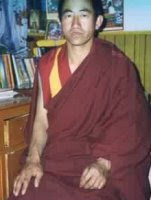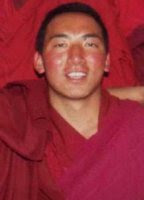Agam's Gecko


Saturday, March 28, 2009
THE NEW SERFDOM **updated**
*update at end of article*
| F |
ifty years ago today, the ruling Communist Party of China formally erased the last semblance of self-government in Tibet and placed its colony under direct rule. Three days later the Tibetan head of state, His Holiness the Dalai Lama, crossed the Indian border and entered his life-long freedom in exile.
Today the shackles on the Tibetan people remain quite firmly in place, and they still haven't gotten into the spirit for celebrating the loss of their country half a century ago.
Further reports have been received regarding the current situation in Ragya, where a massive public demonstration took place last Sunday. Additional sources have told the Tibetan Centre for Human Rights and Democracy that copies of three separate pamphlets were distributed and posted on walls in the town. It's not clear whether this leafleting was part of last Sunday's protest, as this activity was previously reported on March 9-10, which led to the original lock-down of the monastery. One of the pamphlets apparently referred to recent Chinese attempts to buy Tibetan participation in celebrating communist rule, and concluded:
"It is better to die for Tibet and her people than being duped by the monetary rewards of the Chinese government."Sources have also confirmed to TCHRD that Tashi Sangpo, whose apparent death by drowning after a daring slip from police on March 21 was the trigger for massive public protest, had been held in detention since his arrest on March 10 and was subjected to harsh beatings, torture and long interrogation sessions prior to his escape.
Sources told TCHRD that continuing torture and interrogation finally took its toll on Tashi Sangpo's mental state, which eventually forced him to take his own life by drowning in Machu River. In addition, the detained monks were currently said to be undergoing severe interrogation and torture in detention centre.
Thereafter, the highest ranking government official in Golog Prefecture, head of Golog PSB personnel and People's Armed Police (PAP) came to the protesting site. Unfazed by the intimidating presence of PSB and PAP forces, the Tibetans continued to protest, holding and waving the banned Tibetan National flag and shouted a slogan "STOP MURDERING THE INNOCENT TIBETAN PEOPLE".Another source, who had been in contact with people in Ragya on that day, spoke at length with Free Tibet Campaign in London about what he had learned. The raising of the Tibetan national flag over the monastery had occurred on March 9, but Tashi Sangpo and six other monks were not arrested until a security raid on the monastery on March 20, according to this source. Separate reports indicated that several military trucks had initially arrived at the monastery on March 8, and military patrols were deployed around the monastery.
Eyewitnesses told the sources that they had seen Sangpo jump into the river after running from the police station. The eyewitnesses, who were located on a bridge spanning the river, told the source that they had seen Sangpo’s body being swept under the bridge by the river’s strong current and had lost sight of his body shortly after.
Several more of the monks arrested on Sunday have been identified. In addition to the monastery prefect, Palden Gyatso, three others were named as Soepa, 42, Gyaltsen, 34, and Jamyang Khedup, 27. In earlier reports, Chinese officials said that of the 95 Tibetans being held, only two were laypeople. One of these has been identified by Tibetan sources as Yanglo, aged 54. Relatives and friends of Tashi Sangpo are being detained and questioned at a police station located about 2 km from the monastery.
The 28 year old incarnate lama accused the government in his letter of having desecrated his monastery, and demanded that the troops must withdraw from their occupation of the institution. Insisting that issues must be resolved peacefully, he wrote that the central, provincial and local administrations will be held responsible for the ongoing unrest in Tibet. Shingsa Rinpoche fled the Chinese occupation in 1997, and is known as a strong supporter of Tibetan independence.
The authorities' earlier assertion had been touted in the state-controlled mouth-piece media by the citation of one "witness" who claimed to have seen Tashi Sangpo swim out of the river and flee. That woman is now being held in Chinese custody, local people told Shingsa Rinpoche.
The people of Dzogchen township, in Derge County, western Kardze Prefecture, were preparing to observe Phurchen, an important day for their religious activities, on March 23. On the eve of the event, a large number of leaflets calling for Tibet's independence as well as prayer flags (Lungta) were scattered all over the main road leading to the Dzogchen Monastery.
A lone Tibetan monk staged a protest in Lithang County, also in western Kardze T-"A"-P, at around 11:20 am on Sunday morning, March 22. Choekyong Tsering, an 18 year old monk from Lithang Monastery, shouted slogans for the long life of His Holiness Dalai Lama and for Tibetan independence. He was severely beaten by security forces before being swept off to Lithang county prison.
Radio Free Asia reported on what may have been the same incident. On March 24, two nuns from Lamdrak Nunnery scattered several hundred leaflets in front of the Kardze PSB headquarters before they were beaten and detained. This account identified the nuns as Yangkyi and Sonam Yangchen.
"More than 50 security personnel arrived at the scene. Some of them detained and beat the nuns while others cordoned off the area. Even after being beaten, the nuns called out for the long life of the Dalai Lama."
"Both nuns were placed in a military van and taken away," the source said.
"Witnesses saw Chinese PSB personnel detaining them and beating them with iron rods and rifle butts," he added.Authorities responded by calling a meeting at Lopa village, warning farmers that if they failed to work their fields they would be detained and their land confiscated. The Kardze region has been experiencing the most bizarre prelude to the forced celebration of the new, CCP-mandated public holiday — "Serfs' Emancipation Day" — which falls today.
After this, "several posters appeared in Tibetan villages lying in the outskirts of Kardze [town], urging farmers to refuse to cultivate their land in protest against Chinese rule," [Yeshe] Dorje said.
"Tibetans who did till their land were warned of 'serious consequences,'" he said.
Which leads me to wonder whether communists are actually able to perceive irony. Here is more of what I call, "The New Serfdom":
"On March 20, over 100 government workers, Public Security Bureau (PSB) officers, and soldiers came to Kara village in Kardze," Yeshe Dorje, a former resident of Kardze now living in Australia, said, citing sources in the region.
"They went from house to house and forced Tibetans into their fields and made them till their land. The Tibetans didn’t cooperate [at first] but later tilled their fields under pressure and with the assistance of government workers and security personnel," Dorje said.
He added that Tibetans are still boycotting in other parts of Kardze, where opposition to China runs strong.
All major monasteries in Lhasa have been closed in the run-up to the new state serfs' holiday, and only the Potala and the Jokhang remain open. There are believed to be only around 100 monks in residence at the Jokhang Temple — hardly enough to go around, if residents of Lhasa were actually inclined to celebrate or honour a particular occasion. Under such conditions, a trip to the monastery to pay respect to the monks and to visit the shrines would probably figure into the holiday plans of many.
But the monasteries are closed now, and there's nothing for Lhasans to celebrate in any case. One of them told RFA that the state celebrations are "showings-off" against the Dalai Lama, adding, "The government will hold jubilant celebrations. However, they are irrelevant to religion in Tibet."
A Tibetan writer-photographer was arrested for his work on a Tibetan website, Zin-dris ("Jottings") on March 17. Kunga Tsayang, a monk at Labrang Monastery in Sangchu County, Amdo, was seized from his room during a midnight raid by Public Security Bureau personnel.
Described as a well educated monk who takes great pride in his Tibetan identity, he is known as a serious writer and photographer who has travelled across China and Tibet documenting Tibetan landscapes, cultures, customs and religion. He had reportedly been under close watch by authorities in Sangchu County, but stayed only rarely at Labrang during important rituals and ceremonies.
Reporters Without Borders issued a press statement condemning the arrest of Kunga Tsayang, as well as the re-arrest of documentarian Jigme Gyatso ("Leaving Fear Behind"), and urged the Chinese government to release him immediately. The journalists' advocacy group cited his "many articles about Buddhism and Tibetan art and culture," and noted that he is also an avid environmentalist working with the Yutse Environment Department as a photographer. Kunga Tsayang is 20 years old.
UPDATE: Received in comments from Tibet Writes, an English translation of one of Kunga Tsayang's short essays may be read here: Who are the real separatists?.
.
Labels: Tibet











 Our way of saying "thanks" in the Thai way. Here a nak muay Thai (kickboxer) offers respect and thanks for his teacher (wai khru) before a match. This is our local variation on the ubiquitous "hat tip" used in general blog culture.
Our way of saying "thanks" in the Thai way. Here a nak muay Thai (kickboxer) offers respect and thanks for his teacher (wai khru) before a match. This is our local variation on the ubiquitous "hat tip" used in general blog culture.
















